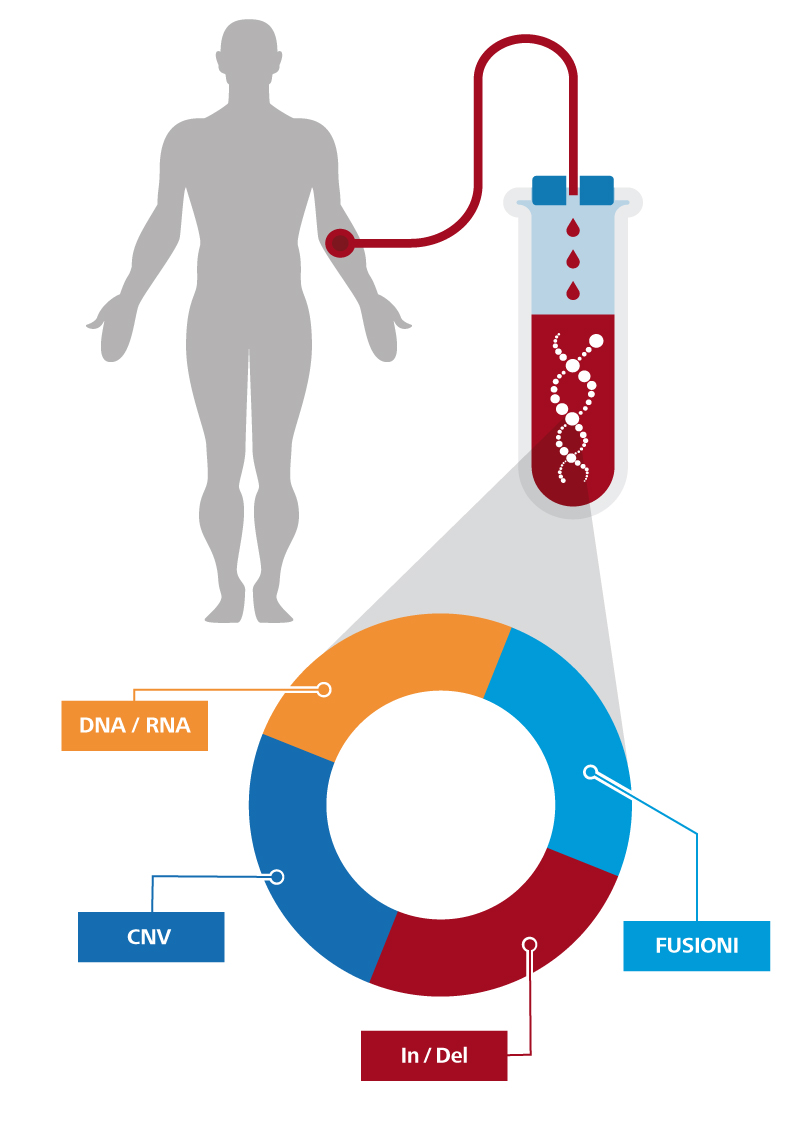La Biopsia Liquida
Queste potenzialità forniscono opportunità diagnostiche preziose e non altrimenti ottenibili.

-
- Come si esegue
La biopsia liquida si ottiene mediante un semplice prelievo venoso con raccolta in provette dedicate. Il prelievo può essere eseguito prima, dopo e durante la terapia farmacologica.
-
- Utilità clinica
La biopsia liquida consente di ottenere informazioni sui driver genetici del tumore e di monitorarne l’evoluzione. Attraverso questa tecnica è pertanto possibile individuare terapie mirate e personalizzate e di detectare precocemente l’insorgenza di mutazioni correlate a resistenza consentendo uno switch farmacologico. In caso di impossibilità ad eseguire campioni bioptici, la biopsia liquida può essere utilizzata per la tipizzazione genetica del tumore.
-
- Geni indagati
I geni indagati sono tutti quelli che hanno utilità clinica e un razionale di letteratura o di trials clinici in corso.
-
- La nostra biopsia liquida
La tecnica utilizzata consente di ottenere il maggior numero di informazioni “cliniche” in un unico prelievo. Rispetto ad altre tecnologia, la biopsia liquida eseguita presso l’Istituto Varelli, indaga il maggior numero di varianti cosiddette “actionable” ovvero varianti per le quali sono disponibili farmaci o altri comportamenti terapeutici.
Classificazione dei Geni "Actionable"
KRAS
NRAS
BRAF
ALK
The anaplastic lymphoma kinase (ALK) is a receptor tyrosine kinase that is altered in a number of cancers. Activating mutations in the full length ALK have been identified in neuroblastomas whereas structural alterations consisting of the ALK tyrosine kinase domain fused to a separate gene product have been identified in colon, ovarian and non-small cell lung cancers where ALK fusions comprise approximately 3-5% of lung tumors. The majority of ALK fusion variants have been identified to contain portions of the echinoderm microtubule -associated protein-like 4 (EML4) gene fused to the ALK tyrosine kinase. Although ALK fusion products have been shown to confer sensitivity to ALK tyrosine kinase inhibitors, emergence of mutations in the ALK kinase domain have been reported to confer resistance to treatment.
EGFR
KIT
PDGFRA
The anaplastic lymphoma kinase (ALK) is a receptor tyrosine kinase that is altered in a number of cancers. Activating mutations in the full length ALK have been identified in neuroblastomas whereas structural alterations consisting of the ALK tyrosine kinase domain fused to a separate gene product have been identified in colon, ovarian and non-small cell lung cancers where ALK fusions comprise approximately 3-5% of lung tumors. The majority of ALK fusion variants have been identified to contain portions of the echinoderm microtubule -associated protein-like 4 (EML4) gene fused to the ALK tyrosine kinase. Although ALK fusion products have been shown to confer sensitivity to ALK tyrosine kinase inhibitors, emergence of mutations in the ALK kinase domain have been reported to confer resistance to treatment.
ERBB2
PIK3CA
ERBB3
The anaplastic lymphoma kinase (ALK) is a receptor tyrosine kinase that is altered in a number of cancers. Activating mutations in the full length ALK have been identified in neuroblastomas whereas structural alterations consisting of the ALK tyrosine kinase domain fused to a separate gene product have been identified in colon, ovarian and non-small cell lung cancers where ALK fusions comprise approximately 3-5% of lung tumors. The majority of ALK fusion variants have been identified to contain portions of the echinoderm microtubule -associated protein-like 4 (EML4) gene fused to the ALK tyrosine kinase. Although ALK fusion products have been shown to confer sensitivity to ALK tyrosine kinase inhibitors, emergence of mutations in the ALK kinase domain have been reported to confer resistance to treatment.

